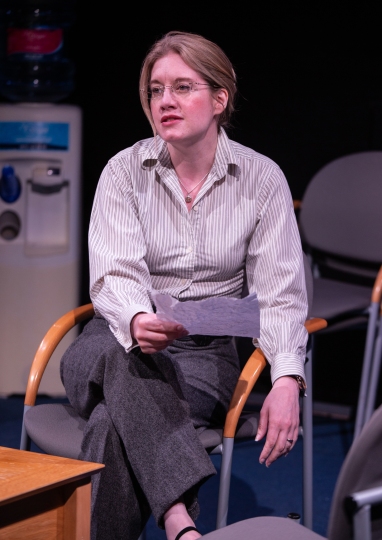Blue/Orange
Colour Blind
Blue/Orange
by Joe Penhall
Questors at The Studio, Ealing until 11th May
Review by Eleanor Lewis
The desperate state of NHS funding doesn’t automatically create a draw to a play about it. You could say the same about the difficult process of getting your child into a particular school. So deeply, however, are we all engaged with these two huge concerns, and so many and varied are the issues they throw up that more than a couple of successful plays on these two subjects have entertained appreciative audiences over the last few years. Indeed Questors itself recently produced a highly successful version of Future Conditional, Tamsin Oglesby’s play on the subject of school admissions.

So the prospect of Blue/Orange, Joe Penhall’s play in which the treatment of an NHS patient with mental health issues is explored, is these days attractive in itself and even more so when based on the experience of the high standard of Questors’ recent productions.

The three characters in Blue/Orange have almost equal stage time. Junior doctor Emily, consultant Robert, and patient Christopher interact in an office with soft seats of muted colours, a water cooler and a small table on which is a bowl of oranges. The lighting is clear and slightly harsh, suggesting the strip lights of a public building where the design aimed for comfort but was shot down by the budget.
 Emily is struggling to keep Christopher in hospital; he wants to go home; she thinks he isn’t ready. Robert, the senior medic needs the bed and the cash currently taken up dealing with Christopher. Robert also, it transpires, views Christopher as prime research guinea pig for his pet theory that mental illness within ‘the black community’ is caused largely by white clinicians simply failing to understand ‘them’. As events progress, Robert reveals himself often willingly, as both the epitome of arrogance and a supreme manipulator. Adam Kimmel in this role (and in two beautifully tailored suits) moves seamlessly from avuncular mentor to power-crazed despot, leaving the audience almost gasping at the audacity of it all.
Emily is struggling to keep Christopher in hospital; he wants to go home; she thinks he isn’t ready. Robert, the senior medic needs the bed and the cash currently taken up dealing with Christopher. Robert also, it transpires, views Christopher as prime research guinea pig for his pet theory that mental illness within ‘the black community’ is caused largely by white clinicians simply failing to understand ‘them’. As events progress, Robert reveals himself often willingly, as both the epitome of arrogance and a supreme manipulator. Adam Kimmel in this role (and in two beautifully tailored suits) moves seamlessly from avuncular mentor to power-crazed despot, leaving the audience almost gasping at the audacity of it all.
 Clare Purdy is highly appealing as Emily, the junior doctor. Already an intense character, she moves through confusion, frustration, indignation and back again as she struggles to fight Christopher’s corner, whilst trying to keep her career afloat in the face of Robert’s unbending obstruction. Christopher believes oranges are blue and Idi Amin is his father. Chukwudi Onwere as Christopher, the patient with borderline personality disorder, has created a small time bomb of a man, his constant physical movement and rapid mood swings give rise to nervous tension in everyone around him, at his every appearance the audience sits up to give their full attention, ready for whatever might happen.
Clare Purdy is highly appealing as Emily, the junior doctor. Already an intense character, she moves through confusion, frustration, indignation and back again as she struggles to fight Christopher’s corner, whilst trying to keep her career afloat in the face of Robert’s unbending obstruction. Christopher believes oranges are blue and Idi Amin is his father. Chukwudi Onwere as Christopher, the patient with borderline personality disorder, has created a small time bomb of a man, his constant physical movement and rapid mood swings give rise to nervous tension in everyone around him, at his every appearance the audience sits up to give their full attention, ready for whatever might happen.
There are no scene changes in Blue/Orange and though much happens it is all spoken. There are spiels of weaponised political correctness: Christopher is black, both clinicians are white, but the one with more power is free to exploit all the elements of that particular situation. The struggle for career development and a position within the hierarchy descends into brutal survival of the fittest. But this is also a funny play – not often laugh out loud funny, but funny nonetheless. Perhaps the main strength of this work is that it isn’t possible to predict how it will play out, what will happen next, who if anyone will ‘win’. The emphasis shifts constantly and sympathy moves between all three beleaguered protagonists in this impossible arena, however badly they behave.

For this work Questors Studio was set up so that the audience was either side of a central playing space. This might have been intended to suggest opposing sides watching some sort of combat. Verbal combat there certainly was but the arrangement rather limited the audience experience at either extreme of the seating, the middle sections being closer to the intensity of what took place. This is also quite a long work, at 2 hours 40 minutes and whilst overall it didn’t feel like almost three hours, it must be said that Act One took a little time to build the pace it needed. That aside, Questors’ production of Blue/Orange is very engaging, hugely enjoyable and certainly recommendable.
Eleanor Lewis
May 2019
